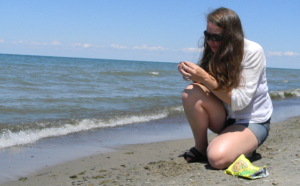
A team of 20 undergraduate students from SUNY Fredonia are embarking on a historic mission over the next two weeks. The researchers will be the first ever to tally the plastic content of the Great Lakes.
Pollution – namely, plastic – is an increasing problem for the entire globe’s ecosystem. According to the U.S. Environmental Protection Agency, there are three main negative impacts that debris like water bottles, cigarette butts (yes, contain plastic) and take-out containers have on an organism’s environment: ingestion, entanglement and ecosystem alteration. In a nutshell, this means that solid waste pollution affects every aspect of a habitat, from feeding to nesting to simply moving.
The Great Lakes is the largest collection of fresh water on Earth and its boundaries are home to 25 million people. With less than 50 percent of consumed plastic finding its way to a landfill, the body of water has become a collection of the material. These alarming statistics have caused creation of the Great Lakes Restoration Initiative, a movement to identify and address adverse factors in the changing ecosystem. The Initiative includes a $6.5M grant from the EPA to study fish in the Great Lakes in conjunction with SUNY Fredonia, SUNY Oswego and neighboring Clarkson University.
This summer’s voyage consists of a twenty-student team to sample Great Lake water content funded by a $10K grant from the Ohio-based Burning River Foundation. The study is headed by Sherri Mason, a SUNY Fredonia professor and will take three weeks to complete.
The tactics the students are employing to count can be as rudimentary as the vessel they are on: The Flagship Niagara, a 19th Century replica wooden ship. To count plastic content in the sand, one simply sits and counts a specific area while looking for tiny broken-down plastic particles called “nurdles”. The tiny bits are a more hidden side of pollution and show just how far-reaching the affects are.
Mason explained to PBS’s Daniel Robison on Innovation Trail, “When you realize how small plastic can be, students will literally spend an hour or two just on one meter of sand picking out all these microplastic pieces.” Mason adds, “I’m like, ‘That’s a nurdle.’ Students are like, ‘Really? That’s plastic?’ They have no idea.”
In other phases of the test, students take water samples and survey organisms.
The results will be published in the fall after the crew returns. Since the study is the first of its kind in the region, Sherri notes that the margin of error will likely be “sizable”. But the impact that this groundbreaking trial has will also be sizable – and the young researchers hope it will usher in a cleaner tomorrow for the organic community.
As for the wooden ship, it lacks an actual shower. Sherri tells Robison, “There gets to be a point where if we smell, then we all smell. It’s one of the things that bonds us together as a crew.”


I think it’s a great approach, not only for cleaning Great Lakes but also to alarm young people. Pollution is a huge issue and even if we have a lot of information about it, even if we recycle we can do more. If we do not fight pollution we are going to run out of drinkable water.